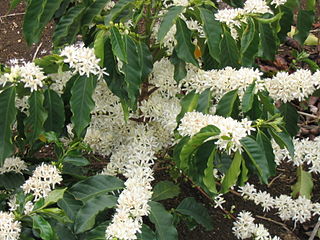
Coffea is a genus of flowering plants in the family Rubiaceae. Coffea species are shrubs or small trees native to tropical and southern Africa and tropical Asia. The seeds of some species, called coffee beans, are used to flavor various beverages and products. The fruits, like the seeds, contain a large amount of caffeine, and have a distinct sweet taste.

Insecticides are pesticides used to kill insects. They include ovicides and larvicides used against insect eggs and larvae, respectively. Insecticides are used in agriculture, medicine, industry and by consumers. Insecticides are claimed to be a major factor behind the increase in the 20th-century's agricultural productivity. Nearly all insecticides have the potential to significantly alter ecosystems; many are toxic to humans and/or animals; some become concentrated as they spread along the food chain.
Pyrethrum was a genus of several Old World plants now classified as Chrysanthemum or Tanacetum which are cultivated as ornamentals for their showy flower heads. Pyrethrum continues to be used as a common name for plants formerly included in the genus Pyrethrum. Pyrethrum is also the name of a natural insecticide made from the dried flower heads of Chrysanthemum cinerariifolium and Chrysanthemum coccineum. The insecticidal compounds present in these species are pyrethrins.

An essential oil is a concentrated hydrophobic liquid containing volatile chemical compounds from plants. Essential oils are also known as volatile oils, ethereal oils, aetheroleum, or simply as the oil of the plant from which they were extracted, such as oil of clove. An essential oil is essential in the sense that it contains the essence of the plant's fragrance—the characteristic fragrance of the plant from which it is derived. The term "essential" used here does not mean indispensable or usable by the human body, as with the terms essential amino acid or essential fatty acid, which are so called because they are nutritionally required by a living organism.

Coffee is a beverage prepared from roasted coffee beans. Darkly colored, bitter, and slightly acidic, coffee has a stimulating effect on humans, primarily due to its caffeine content. It has the highest sales in the world market for hot drinks.

Coffea arabica, also known as the Arabic coffee, is a species of flowering plant in the coffee and madder family Rubiaceae. It is believed to be the first species of coffee to have been cultivated and is currently the dominant cultivar, representing about 60% of global production. Coffee produced from the less acidic, more bitter, and more highly caffeinated robusta bean makes up most of the remaining coffee production. The natural populations of Coffea arabica are restricted to the forests of South Ethiopia and Yemen. Coffea arabica is called بُنّ in Arabic.
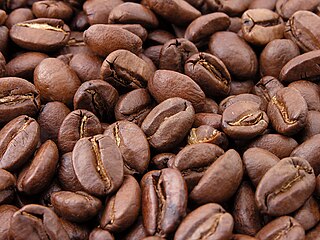
A coffee bean is a seed of the Coffea plant and the source for coffee. It is the pip inside the red or purple fruit. This fruit is often referred to as a coffee cherry. Just like ordinary cherries, the coffee fruit is also a so-called stone fruit. Even though the coffee beans are not technically beans, they are referred to as such because of their resemblance to true beans. The fruits; cherries or berries, most commonly contain two stones with their flat sides together. A small percentage of cherries contain a single seed, instead of the usual two. This is called a "peaberry". The peaberry occurs only between 10% and 15% of the time, and it is a fairly common belief that they have more flavour than normal coffee beans. Like Brazil nuts and white rice, coffee beans consist mostly of endosperm.

An insect repellent is a substance applied to the skin, clothing, or other surfaces to discourage insects from landing or climbing on that surface. Insect repellents help prevent and control the outbreak of insect-borne diseases such as malaria, Lyme disease, dengue fever, bubonic plague, river blindness, and West Nile fever. Pest animals commonly serving as vectors for disease include insects such as flea, fly, and mosquito; and ticks (arachnids).

Coffea canephora is a species of coffee that has its origins in central and western sub-Saharan Africa. It is a species of flowering plant in the family Rubiaceae. Though widely known as Coffea robusta, the plant is scientifically identified as Coffea canephora, which has two main varieties, robusta and nganda.

Beauveria bassiana is a fungus that grows naturally in soils throughout the world and acts as a parasite on various arthropod species, causing white muscardine disease; it thus belongs to the group of entomopathogenic fungi. It is used as a biological insecticide to control a number of pests, including termites, thrips, whiteflies, aphids and various beetles. Its use in the control of bedbugs and malaria-transmitting mosquitos is under investigation.

The silverleaf whitefly is one of several species of whitefly that are currently important agricultural pests. A review in 2011 concluded that the silverleaf whitefly is actually a species complex containing at least 40 morphologically indistinguishable species.
A biopesticide is a biological substance or organism that damages, kills, or repels organisms seen as pests. Biological pest management intervention involves predatory, parasitic, or chemical relationships.

The Miridae are a large and diverse insect family at one time known by the taxonomic synonym Capsidae. Species in the family may be referred to as capsid bugs or "mirid bugs". Common names include plant bugs, leaf bugs, and grass bugs. It is the largest family of true bugs belonging to the suborder Heteroptera; it includes over 10,000 known species, and new ones are being described constantly. Most widely known mirids are species that are notorious agricultural pests that pierce plant tissues, feed on the sap, and sometimes transmit viral plant diseases. Some species however, are predatory.
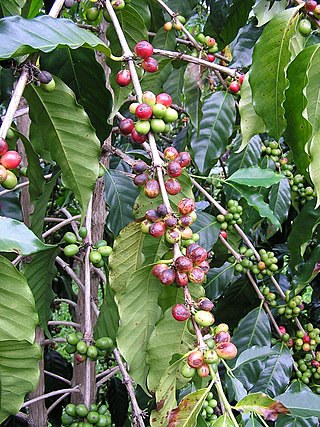
Mycosphaerella coffeicola is a sexually reproducing fungal plant pathogen. It is most commonly referred to as the asexual organism Cercospora coffeicola.
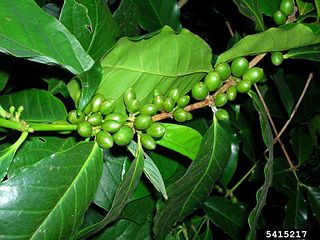
Colletotrichum kahawae is a fungal plant pathogen that causes coffee berry disease (CBD) on Coffea arabica crops. The pathogen is an ascomycete that reproduces asexually. The asexual spores (conidia) are stored within acervuli. This disease is considered to be one of the major factors hampering C.arabica production in the African continent, which represents the current geographic range of the fungus. Coffee berry disease causes dark necrosis in spots and causes the green berries of the coffee to drop prematurely. High humidity, relatively warm temperatures, and high altitude are ideal for disease formation. Given the severity of the disease and the lack of effective control measures, there is great concern that the fungus may spread to other coffee producing continents, such as South America, which could have catastrophic consequences.
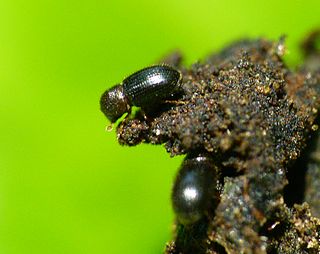
Hypothenemus hampei, the coffee berry borer or coffee borer beetle, is a small beetle native to Africa. It is among the most harmful pests to coffee crops across the world where coffee is cultivated. Spanish common names of the insect include barrenador del café, gorgojo del café, and broca del café.
Antestia is a genus of African and Asian bugs in the subfamily Pentatominae, erected by Carl Stål, 1865.
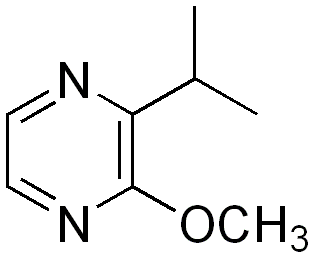
Isopropyl methoxypyrazine (IPMP) is a methoxypyrazine, a class of chemical compounds that produce odors. The odor is rather undesirable and is produced by the Asian lady beetle or by the actinomycete Streptomyces sp. It can be detected by human taste at concentrations of as low as 2 nanograms per litre.
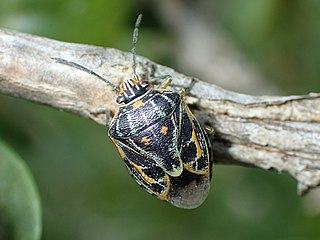
The Antestiini are a tribe of shield-bugs, in the subfamily Pentatominae erected by William Lucas Distant in 1902. Genera are distributed from Africa to South-East Asia and Australia; in West Africa genera such as Antestiopsis are significant coffee pests.



















